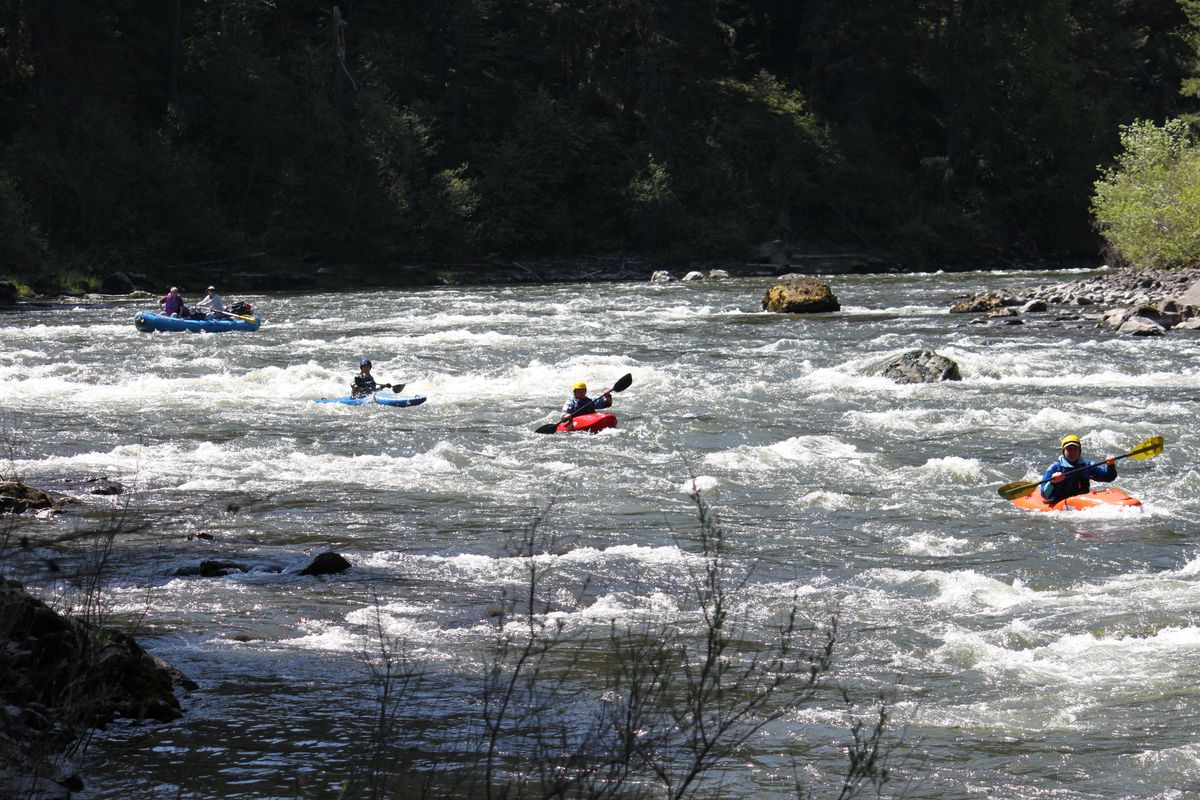Grande Ronde River boasts spectacular scenery, easy whitewater

MINAM, Ore. – Most folks don’t know it, but a three-day trip down the Grande Ronde River would do them a world of good. Out there, far from cell phones and e-mail, life is reduced to its most basic rhythms.
There’s time for laughter with friends, paddling easy whitewater by day, and sleeping under the stars at night. It’s a tonic to the soul, and by the time the trip is over, most folks are invigorated and ready to face the world they left behind.
Some friends and I were there earlier this month, paddling a few hours each day, then setting up sumptuous camps amid majestic stands of ponderosa pines. For three days, ours was a high-tech version of a Huck Finn river trip. To borrow a phrase from Sir Earnest Shackleton, “In memories we were rich. We had pierced the veneer of outside things …”
Deep inside the lushly forested canyon, nature calls the tune and humans are but visitors who cannot remain. Eagles patrol the skies, wheeling elegantly, prowling for their next meal. Bighorn sheep placidly graze the hillsides. Shy deer browse at water’s edge, alert and ready to bolt. Canada geese keep a watchful eye on fuzzy goslings. Fish jump to take flies. Unseen in the forest, male grouse drum their breasts to attract the ladies.
Full of life, the canyon is framed by basalt cliffs with spires that droop like candles near a fire. At the bottom of it all, a river runs through it – clean, clear, and cold.
The setting is magnificent, worthy of a high-minded expedition like Shackleton’s.
Alas, ours was more of a Monty Python troupe, featuring two middle-aged scientists coming of age in kayaks. I’ll call them “Michael Knoblauch” and “Asaph Cousins,” and they were thirsty for some whitewater after learning the Eskimo roll last winter.
In a swimming pool.
Of course, knowing how to roll a kayak – in a pool, no less – is a far cry from knowing how to steer down a whitewater river. So I organized a “graduation party” on the Grande Ronde, which is a forgiving river on which to learn.
We scheduled the trip to coincide with graduation weekend at Washington State University, where Knoblauch and Cousins are professors in WSU’s School of Biological Sciences. It was an auspicious date, given that the ugly pool ducklings were ready to graduate into graceful whitewater swans.
That was the plan, anyway.
In addition to the novices, our party also included an experienced kayaker, Bill Kabasenche, who is a philosophy professor and medical ethics specialist at WSU. The other four members of our group travelled on a pair of self-bailing rafts.
Like most parties, we launched on the Wallowa River at the hamlet of Minam, then paddled 10 miles downstream to its confluence with the Grande Ronde. Due to a skimpy snowpack, the river was unusually low – which was good news for the fledgling kayakers. Neither the Wallowa, nor the Ronde was swift or pushy, which allowed our rookies to take their time when picking a line through Class 2-3 rapids.
Low water also meant a lot of rocks poking out of the water, so everyone had to be alert for trouble. Fortunately, the first few navigational challenges on the Wallowa came and went without incident.
Then we arrived at an ominously-named rapid known, drumroll, as “Blind Falls.” At low flows, it’s a rock garden that gathers intensity before culminating in a hefty hydraulic hole at the bottom.
One by one, the rafts and kayaks navigated its heaving wave train and dodged the big hole. Finally, Prof. Cousins made his move.
With the inevitability of a Greek tragedy, small mistakes – such as leaning the wrong way, missing a crucial paddle stroke – blossomed into problems. By the end of the rapid, the bottom of his boat was facing the sky and Prof. Cousins was performing a manual fish survey.
His prowess in the pool a thing of the past, Prof. Cousins flailed and failed to roll himself upright. Throwing pride to the wind, he wiggled out of his boat and entered the water like a new-age amphibian.
Fortunately, the only damage was to his dignity. He corralled his boat, swam to shore, shoehorned himself back inside, and rejoined his guffawing colleagues downstream.
In camp that night, Prof. Cousins graciously performed the ancient ritual of whitewater paddlers who suffer an out-of-boat experience: He filled a neoprene bootie with beer and, with all the poise he could muster, he guzzled it down.
“The bootie is only three months old,” he explained afterward, “so it really wasn’t that bad.”
With that, he grabbed a more conventional drinking vessel and filled it with a restorative beverage. The rest of us joined him, and we turned our camp chairs to behold the river that delivered us. Glasses were raised and brought together with the unmistakable “clink” that defines friendship.
Later, after dinner and dishwashing, there was time to sit and sip fine bourbon. Tents were pitched, just in case, but most of us slept out under a sky full of stars, soothed by the sibilant sounds of the river.
The next morning after breakfast we packed our comfortable camp and kitchen into waterproof bags and boxes, then lashed everything to the rafts. It was a moveable feast, in every sense of the word, and it went on day after day.
There were other swims, and there was a raft that got stuck – briefly, thankfully – on the rocks. More beer was drunk from wetsuit booties. More laughter ensued.
By the time it was over, we few – we happy few, we band of brothers – were better friends than on the day we launched. In that respect, it was just another river trip.